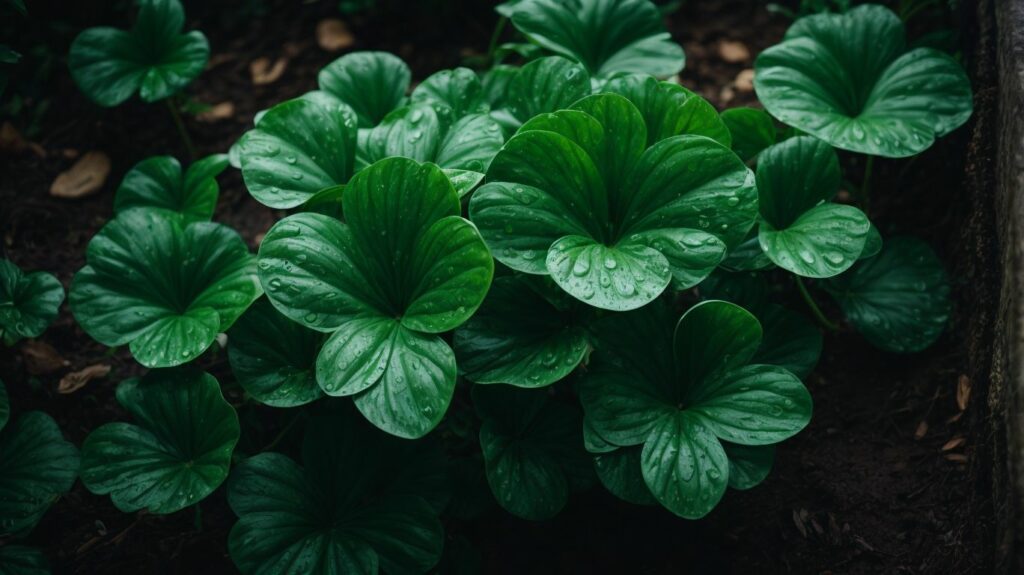Watermelon Peperomia, also known as Peperomia argyreia, is a popular houseplant appreciated for its unique foliage that resembles the rind of a watermelon. This low-maintenance plant is native to South America and makes for a beautiful addition to any indoor space. However, to ensure healthy growth and vibrant foliage, it is crucial to provide the right growing conditions, including the ideal soil.
The ideal growing conditions for watermelon peperomia include temperatures between 65-75°F and bright, indirect light. Choosing the right soil is equally important, as it provides the necessary nutrients and moisture for the plant to thrive.
When it comes to soil, there are various options available for watermelon peperomia, each with its unique benefits. These include:
- Peat-based Potting Mix: This is a popular choice for watermelon peperomia as it is rich in organic matter and provides good drainage.
- Perlite-based Potting Mix: This mix is lightweight and porous, providing good aeration and drainage for the plant’s roots.
- Vermiculite-based Potting Mix: This mix retains moisture well and is a good option for plants that require high humidity.
- Coir-based Potting Mix: Made from coconut fiber, this mix is sustainable and provides good drainage and aeration for the plant’s roots.
Using the best soil for watermelon peperomia offers several benefits, including:
- Provides Adequate Drainage: Good drainage is crucial for watermelon peperomia as it prevents the roots from sitting in water, which can lead to root rot.
- Maintains Moisture Levels: The right soil will help maintain the ideal moisture levels for the plant, preventing it from drying out or becoming waterlogged.
- Supplies Essential Nutrients: High-quality soil is rich in essential nutrients that are necessary for plant growth and development.
- Prevents Root Rot: Using well-draining soil can prevent root rot, a common problem in watermelon peperomia.
When choosing the best soil for watermelon peperomia, keep in mind the following factors:
- Check the pH Level: Watermelon peperomia prefers slightly acidic soil with a pH range of 5.5-6.5.
- Look for Organic Materials: High-quality soil should contain organic materials such as peat moss or compost to provide essential nutrients.
- Consider the Texture: The soil should be well-aerated and have a loose texture to allow for proper drainage and root growth.
- Avoid Compacted Soils: Compacted soils can hinder root growth and prevent proper drainage, leading to the plant’s decline.
Key Takeaways:
- Avoid using compacted soils when choosing the best soil for Watermelon Peperomia to prevent root rot and promote healthy growth.
- Choose a potting mix with a balanced pH level and organic materials to provide necessary nutrients and maintain moisture levels for Watermelon Peperomia.
- For ideal growing conditions, Watermelon Peperomia prefers a peat-based or coir-based potting mix with good drainage and indirect light.
What Is Watermelon Peperomia?
Watermelon Peperomia is a well-known houseplant recognized for its distinct foliage that resembles watermelon rinds. Belonging to the Peperomia family, this plant is one of many small, succulent plants. It thrives in bright, indirect light and well-draining soil. To keep the plant healthy, it is important to water it when the top inch of soil is dry. Regular pruning is recommended to promote compact growth and removing any yellowing leaves is a necessary part of care. For indoor gardening enthusiasts looking to add a touch of fun and whimsy to their collection, Watermelon Peperomia is an excellent choice.
What Are the Ideal Growing Conditions for Watermelon Peperomia?
Watermelon Peperomia thrives in specific growing conditions that mimic its natural habitat.
- Light: It prefers bright, indirect light, but can tolerate some shade.
- Temperature: Ideal temperatures range from 65-80°F (18-27°C).
- Humidity: It prefers high humidity levels, around 50-60%. Regular misting can help maintain optimal humidity levels.
- Soil: To prevent waterlogging, it is crucial to use well-draining soil. A mix of peat moss, perlite, and sand works well for Watermelon Peperomia.
- Watering: It is important to allow the soil to dry slightly between waterings to avoid both overwatering and underwatering.
- Fertilizer: During the growing season, feed with a balanced, water-soluble fertilizer once a month.
By providing these ideal conditions, you can cultivate healthy and vibrant Watermelon Peperomia.
What Temperature Does Watermelon Peperomia Prefer?
Watermelon Peperomia thrives in temperatures between 65 to 75 degrees Fahrenheit (18 to 24 degrees Celsius). It prefers a warm and consistent temperature, avoiding extreme heat or cold. It is important to avoid exposing the plant to drafts or cold windows during the winter months. Keeping the temperature within this range will help promote optimal growth and prevent any unnecessary stress on the plant.
What Type of Light is Best for Watermelon Peperomia?
Watermelon Peperomia thrives in bright, indirect light conditions. It prefers moderate to high light, but can also tolerate lower light levels. Placing the plant near a window with filtered light or using artificial grow lights can provide the ideal lighting conditions. Direct sunlight should be avoided as it can cause the leaves to burn. Adequate light is crucial for the healthy growth and vibrant foliage of Watermelon Peperomia, so it is important to provide it with the right amount of light for its well-being and beautiful appearance.
What Type of Soil is Best for Watermelon Peperomia?
Watermelon Peperomia thrives in soil that is well-draining and able to retain moisture without becoming waterlogged. The ideal soil type for this plant is a combination of peat, perlite, and vermiculite, as it provides sufficient drainage, maintains moisture levels, and supplies necessary nutrients. This mixture also helps prevent root rot, a common issue with watermelon peperomia. When selecting soil, it is important to consider the pH level, opt for organic materials, and ensure the texture is loose and well-aerated. Compacted soils should be avoided as they can hinder root development.
Fun fact: Watermelon Peperomia gets its name from the resemblance of its leaves to the rind of a watermelon!
What Are the Different Types of Soil for Watermelon Peperomia?
When it comes to growing a healthy and thriving watermelon peperomia plant, choosing the right type of soil is crucial. In this section, we will discuss the different types of soil that are suitable for watermelon peperomia plants. From peat-based potting mix to coir-based potting mix, we will explore the unique characteristics and benefits of each type of soil. By the end, you will have a better understanding of which soil is best for your watermelon peperomia to thrive.
1. Peat-based Potting Mix
A popular choice for growing watermelon peperomia is a potting mix that is based on peat. This type of mix is known for its ability to provide adequate drainage, maintain moisture levels, supply essential nutrients, and prevent root rot. To choose the best peat-based potting mix, follow these steps:
- Check the pH Level: Make sure the potting mix has a pH level between 6 and 7, as this is ideal for watermelon peperomia.
- Look for Organic Materials: Opt for mixes that contain organic matter, such as peat moss, which helps to retain moisture and provide nutrients.
- Consider the Texture: Choose a mix with a light and fluffy texture that allows for proper aeration of the roots.
- Avoid Compacted Soils: Steer clear of mixes that are overly compacted, as they can hinder root growth and water drainage.
2. Perlite-based Potting Mix
Perlite-based potting mix is an excellent choice for growing Watermelon Peperomia due to its superior drainage properties and ability to retain moisture. This lightweight option helps prevent root rot by allowing excess water to drain quickly. Additionally, the perlite particles create air pockets in the soil, promoting healthy root development.
When selecting a perlite-based mix, make sure to check for a pH level suitable for Watermelon Peperomia and seek out organic materials that provide essential nutrients. It is also important to consider the texture of the mix, ensuring that it is loose and well-draining. Avoid using compacted soils that can hinder root growth.
3. Vermiculite-based Potting Mix
Vermiculite-based potting mix is a suitable option for growing watermelon peperomia. Here are some steps to follow when using this type of soil:
- Start with a container filled with vermiculite-based potting mix.
- Ensure the potting mix is well-draining to prevent waterlogged roots.
- Moisten the soil before planting to provide a good starting environment for the plant.
- Make a small hole in the soil and gently place the watermelon peperomia cutting or transplant into it.
- Cover the roots with additional potting mix and lightly press it down around the plant.
- Water the plant thoroughly after planting and maintain consistent moisture levels.
By using vermiculite-based potting mix, you provide the watermelon peperomia with adequate drainage, moisture retention, and essential nutrients. It also helps prevent root rot. Remember to check the pH level, look for organic materials, consider the texture, and avoid compacted soils when choosing the best soil for watermelon peperomia.
4. Coir-based Potting Mix
Coir-based potting mix is the ideal choice for growing watermelon peperomia as it offers excellent drainage and moisture retention properties. To effectively use coir-based potting mix for your watermelon peperomia, follow these simple steps:
- Begin by soaking the potting mix in water until it expands and becomes moist.
- Next, fill a pot with the moistened coir-based potting mix.
- Gently remove the watermelon peperomia from its current container and carefully loosen the roots.
- Place the plant in the pot, ensuring that the roots are evenly spread out.
- Add more potting mix around the plant, gently pressing it down to secure the plant in place.
- Thoroughly water the plant, allowing any excess water to drain away.
- Position the pot in an area with bright, indirect light.
- Regularly check the moisture levels and water the plant when the top inch of soil feels dry.
Using a coir-based potting mix will provide your watermelon peperomia with the perfect balance of drainage, moisture, and nutrients for optimal growth. Watch as your watermelon peperomia flourishes in its new home!
What Are the Benefits of Using the Best Soil for Watermelon Peperomia?
Choosing the right soil for your watermelon peperomia plant is crucial for its overall health and growth. In this section, we will discuss the importance of using the best soil for watermelon peperomia and the benefits it can provide. From proper drainage and moisture levels to essential nutrients and preventing root rot, the right soil can make a significant difference in the success of your plant. Let’s dive into the details of each benefit and how it contributes to the well-being of your watermelon peperomia.
1. Provides Adequate Drainage
Adequate drainage is crucial for the healthy growth of watermelon peperomia. Here are some steps to ensure proper drainage:
- Use a well-draining potting mix specifically formulated for indoor plants.
- Add a layer of small stones or pebbles at the bottom of the pot to create a drainage layer.
- Choose a pot with drainage holes to allow excess water to escape.
- Water the plant thoroughly but avoid overwatering to prevent waterlogged soil.
By providing proper drainage, you can prevent root rot and promote optimal growth for your watermelon peperomia.
2. Maintains Moisture Levels
To ensure that your Watermelon Peperomia maintains optimal moisture levels for its growth and health, follow these steps:
- Choose the right potting mix: Look for a mix that retains moisture, such as peat-based or coir-based potting mix.
- Incorporate organic materials: Add compost or well-rotted manure to the potting mix to improve moisture retention.
- Properly water your plant: Thoroughly water your plant, allowing excess water to drain out. Avoid overwatering to prevent root rot.
- Mulch the soil: Apply a layer of organic mulch around the plant to help maintain moisture and regulate temperature.
By implementing these steps, you can maintain moisture levels for your Watermelon Peperomia and promote its growth and health.
3. Supplies Essential Nutrients
Watermelon Peperomia requires essential nutrients to thrive and grow healthily. To ensure the plant receives these nutrients, follow these steps:
- Use a potting mix rich in organic materials like compost to provide natural nutrients.
- Consider adding slow-release fertilizers to the soil for a consistent supply of essential nutrients.
- Supplement the soil with liquid fertilizers during the growing season to meet the plant’s nutrient needs and promote optimal health.
- Provide balanced fertilizers containing nitrogen, phosphorus, and potassium to support overall growth and development.
By following these steps and supplying essential nutrients, you can promote the optimal health and vitality of your Watermelon Peperomia plant.
4. Prevents Root Rot
Proper soil selection is crucial in preventing root rot in Watermelon Peperomia. Here are steps to consider when choosing the best soil:
- Check the pH level: Aim for a slightly acidic to neutral soil with a pH range of 6.0-7.0.
- Look for organic materials: Opt for a soil mix that includes organic matter like compost or peat moss to enhance drainage and moisture retention.
- Consider the texture: Choose a well-draining soil that allows excess water to flow through easily, preventing waterlogged conditions.
- Avoid compacted soils: Ensure the soil is loose and not compacted, allowing roots to breathe and preventing water accumulation around them.
By following these steps and using soil that helps to prevent root rot, you can promote healthy growth and overall well-being of your Watermelon Peperomia plant.
How to Choose the Best Soil for Watermelon Peperomia?
Finding the right soil for your watermelon peperomia is crucial for its overall health and growth. In this section, we will discuss the key factors to consider when choosing the best soil for your plant. From checking the pH level to considering the texture, we will cover all the important aspects to ensure your watermelon peperomia thrives in its new home. So let’s dive in and learn how to choose the perfect soil for your beloved plant.
1. Check the pH Level
Checking the pH level of the soil is an essential step in selecting the most suitable soil for Watermelon Peperomia.
- Collect a soil sample using a clean trowel or shovel.
- Utilize a pH testing kit or pH meter to measure the acidity or alkalinity of the soil.
- Follow the instructions provided with the testing kit or meter to obtain an accurate reading.
- Examine the pH level of the soil sample. Watermelon Peperomia thrives in a slightly acidic to neutral soil pH, ideally between 6.0 and 7.0.
- Adjust the pH level if necessary by adding amendments such as lime to raise the pH or sulfur to lower the pH.
2. Look for Organic Materials
When selecting soil for Watermelon Peperomia, it is crucial to search for organic materials that will support its healthy growth. Follow these steps to ensure you choose the right soil:
- Check the packaging: Look for soil mixes that explicitly state they contain organic materials.
- Read the ingredients: Look for components such as compost, peat moss, or aged bark, which will enrich the soil with organic matter.
- Avoid synthetic additives: Stay away from soils that contain synthetic fertilizers or chemicals.
- Consider homemade options: You can create your own organic mix by combining equal parts of compost, peat moss, and perlite or vermiculite.
By using soil enriched with organic materials, you provide Watermelon Peperomia with the necessary nutrients for healthy growth and reduce the risk of chemical exposure.
3. Consider the Texture
When considering the texture of soil for watermelon peperomia, follow these steps:
- Assess the current soil texture by feeling it between your fingers.
- Ensure that the soil is well-draining to prevent waterlogged roots.
- Look for a soil mix with a light, airy texture, such as one that includes perlite or vermiculite.
- Avoid compacted, heavy soils that can suffocate the roots and hinder growth.
In a similar tone, a friend once shared how they mistakenly used compacted soil for their watermelon peperomia, leading to stunted growth. After switching to a well-draining, airy soil, the plant thrived and produced beautiful, healthy leaves.
4. Avoid Compacted Soils
To guarantee optimal growth of Watermelon Peperomia, it is essential to prevent compacted soils. Here are some steps to follow:
- Loosen the Soil: Use a garden fork or tiller to loosen any compacted soil in the planting area.
- Add Organic Matter: Incorporate organic matter into the soil, such as compost or well-rotted manure. This will improve drainage and prevent compaction.
- Avoid Over-Watering: Over-watering can lead to waterlogged soil, which can become compacted. Watermelon Peperomia prefers moist but well-drained soil.
- Monitor Soil Moisture: Regularly check the moisture levels of the soil. Water only when the top inch of soil feels dry to the touch.
- Mulch: Apply a layer of organic mulch around the base of the plant. This will help retain moisture and prevent soil compaction caused by heavy rainfall.
By following these steps, you can ensure that your Watermelon Peperomia thrives in loose, well-drained soil, avoiding the negative effects of compacted soils. Happy gardening!
Frequently Asked Questions
What is the best soil for Watermelon Peperomia?
The best soil for Watermelon Peperomia is a well-draining soil mix, such as 3 parts orchid substrate to 1 part coco coir. This mix will give the plant the necessary moisture and air circulation to thrive.
Is Watermelon Peperomia a light feeder?
Yes, Watermelon Peperomia is considered a light feeder. Too much fertilizer can actually harm the plant, so it is important to use a complete fertilizer sparingly, such as Dyna-Gro Grow.
What are the light requirements for Watermelon Peperomia?
Watermelon Peperomia thrives in bright, indirect sunlight. Too much direct sun can cause the foliage to lose its vibrant color. It can also do well in larger Northern or Eastern exposure windows.
How often should I water my Watermelon Peperomia?
Watering should be done carefully to avoid overwatering, as Watermelon Peperomia is sensitive to extreme changes in soil moisture. It is recommended to keep the plant above 60F (16C) and to monitor its moisture levels carefully, especially in higher light conditions.
Can Watermelon Peperomia tolerate cold drafts?
No, Watermelon Peperomia is sensitive to temperature changes and should be kept away from cold drafts. Keeping the plant in a warm and stable indoor environment is best.
What are some critical care tips for Watermelon Peperomia?
Watermelon Peperomia requires bright conditions, well-draining soil, and careful watering to thrive. It is important to also provide supplementary lighting and avoid cold drafts. Overwatering can be fatal for this plant, so it is important to monitor its moisture levels regularly.



